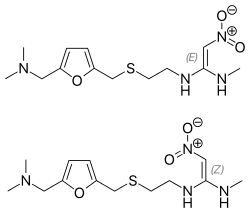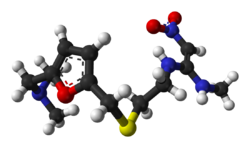
Back رانيتيدين Arabic رانیتیدین AZB রেনিটিডিন Bengali/Bangla Ranitidin Welsh Ranitidin German Ρανιτιδίνη Greek Ranitidina Spanish Erranitidina Basque رانیتیدین Persian Ranitidiini Finnish
 | |
 | |
| Clinical data | |
|---|---|
| Trade names | Zantac,[1] others |
| Other names | Dimethyl [(5-{[(2-{[1-(methylamino)-2-nitroethenyl]amino}ethyl)sulfanyl]methyl}furan-2-yl)methyl]amine, ranitidine hydrochloride (JAN JP) |
| AHFS/Drugs.com | Monograph |
| MedlinePlus | a601106 |
| License data |
|
| Pregnancy category |
|
| Routes of administration | By mouth, intravenous (IV) |
| Drug class | Histamine H2 receptor antagonist, aka H2 blocker[1] |
| ATC code | |
| Legal status | |
| Legal status | |
| Pharmacokinetic data | |
| Bioavailability | 50% (by mouth)[12] |
| Protein binding | 15% |
| Metabolism | Liver: FMOs, including FMO3; other enzymes |
| Onset of action | 55–65 minutes (150 mg dose)[13] 55–115 minutes (75 mg dose)[13] |
| Elimination half-life | 2–3 hours |
| Excretion | 30–70% kidney |
| Identifiers | |
| |
| CAS Number |
|
| PubChem CID | |
| IUPHAR/BPS | |
| DrugBank |
|
| ChemSpider | |
| UNII |
|
| KEGG | |
| ChEBI |
|
| ChEMBL | |
| CompTox Dashboard (EPA) | |
| ECHA InfoCard | 100.060.283 |
| Chemical and physical data | |
| Formula | C13H22N4O3S |
| Molar mass | 314.40 g·mol−1 |
| 3D model (JSmol) | |
| |
| |
| | |
Ranitidine, previously sold under the brand name Zantac[a] among others, is a medication used to decrease stomach acid production.[12] It was commonly used in treatment of peptic ulcer disease, gastroesophageal reflux disease, and Zollinger–Ellison syndrome.[12] It can be given by mouth, injection into a muscle, or injection into a vein.
In September 2019, the probable carcinogen N-nitrosodimethylamine (NDMA) was discovered in ranitidine products from a number of manufacturers, resulting in recalls.[14][15][16][17] In April 2020, ranitidine was withdrawn from the United States market and suspended in the European Union and Australia due to these concerns.[18][19][20][11][21][22]
In 2022, these concerns were confirmed in a Taiwanese nationwide population study finding "significant trends of increased liver cancer risk with an increasing dose of ranitidine" (up to 22% higher than control) and increased gastric, pancreatic, lung[b] and overall[c] cancer risk.[23]
Common side effects include headaches, and pain or burning sensation if given by injection.[12] Serious side effects may include cancer,[24] liver problems, a slow heart rate, pneumonia, and the potential of masking stomach cancer.[12] It is also linked to an increased risk of Clostridium difficile colitis.[25] Ranitidine is an H2 histamine receptor antagonist that works by blocking histamine, thus decreasing the amount of acid released by cells of the stomach.[12]
Ranitidine was discovered in England in 1976, and came into commercial use in 1981.[26] It is on the World Health Organization's List of Essential Medicines.[27][28][29] It has been withdrawn at regulator request from most markets, including the United States;[12] according to the UK NHS, it has been discontinued globally.[30]
- ^ a b c "Zantac 150 (ranitidine hydrochloride) Tablets, USP Zantac 300 (ranitidine hydrochloride) Tablets, USP". DailyMed. 28 June 2018. Archived from the original on 4 July 2022. Retrieved 18 February 2021.
- ^ "Ranitidine use during pregnancy". Drugs.com. 2 December 2019. Archived from the original on 29 October 2019. Retrieved 18 December 2019.
- ^ "Nitrosamine impurities in medications: Medications affected". Health Canada. 19 March 2021. Retrieved 7 January 2024.
- ^ "Acid Reducer (Ranitidine) Tablet: N-nitrosodimethylamine (NDMA) impurity". Health Canada. 6 December 2021. Retrieved 7 January 2024.
- ^ https://pdf.hres.ca/dpd_pm/00003505.PDF
- ^ "Ranitidine 50mg/2ml Solution for Injection and Infusion". medicines.org.uk. 13 October 2021. Retrieved 7 January 2024.
- ^ "Boots Heartburn & Indigestion Relief 75mg Tablets (P)". medicines.org.uk. 3 October 2016. Retrieved 7 January 2024.
- ^ "Boots Heartburn & Indigestion Relief 75mg Tablets". medicines.org.uk. 3 October 2016. Retrieved 7 January 2024.
- ^ "Zantac 150". DailyMed. 3 April 2018. Archived from the original on 4 July 2022. Retrieved 18 February 2021.
- ^ "Ranitidine hydrochloride capsule". DailyMed. 21 November 2018. Retrieved 7 January 2024.
- ^ a b Cite error: The named reference
CHMP withdrawlwas invoked but never defined (see the help page). - ^ a b c d e f g "Ranitidine hydrochloride monograph". The American Society of Health-System Pharmacists. Archived from the original on 9 September 2017. Retrieved 1 December 2015.
- ^ a b Gardner JD, Ciociola AA, Robinson M, McIsaac RL (July 2002). "Determination of the time of onset of action of ranitidine and famotidine on intra-gastric acidity". Alimentary Pharmacology & Therapeutics. 16 (7): 1317–1326. doi:10.1046/j.1365-2036.2002.01291.x. PMID 12144582. S2CID 34396030.
- ^ "Health Canada assessing NDMA in ranitidine". Health Canada. 13 September 2019. Archived from the original on 26 September 2019. Retrieved 26 September 2019.
- ^ "Statement alerting patients and health care professionals of NDMA found in samples of ranitidine". U.S. Food and Drug Administration (FDA). 13 September 2019. Archived from the original on 26 September 2019. Retrieved 26 September 2019.
 This article incorporates text from this source, which is in the public domain.
This article incorporates text from this source, which is in the public domain.
- ^ "EMA to provide guidance on avoiding nitrosamines in human medicines". European Medicines Agency (Press release). 13 September 2019. Archived from the original on 31 December 2019. Retrieved 19 September 2019.
- ^ "FDA updates and press announcements on NDMA in Zantac (ranitidine)". U.S. Food and Drug Administration (FDA). 28 October 2019. Archived from the original on 29 October 2019. Retrieved 28 October 2019.
FDA observed the testing method used by a third-party laboratory uses higher temperatures. The higher temperatures generated very high levels of NDMA from ranitidine products because of the test procedure. The FDA published the method for testing angiotensin II receptor blockers (ARBs) for nitrosamine impurities. That method is not suitable for testing ranitidine because heating the sample generates NDMA.
FDA recommends using an LC-HRMS testing protocol to test samples of ranitidine. FDA's LC-HRMS testing method does not use elevated temperatures and has shown the presence of much lower levels of NDMA in ranitidine medicines than reported by the third-party laboratory. International regulators using similar LC-MS testing methods have also shown the presence of low levels of NDMA in ranitidine samples. This article incorporates text from this source, which is in the public domain.
This article incorporates text from this source, which is in the public domain.
- ^ "Questions and Answers: NDMA impurities in ranitidine (commonly known as Zantac)". U.S. Food and Drug Administration (FDA). 11 October 2019. Archived from the original on 24 October 2019. Retrieved 23 October 2019.
 This article incorporates text from this source, which is in the public domain.
This article incorporates text from this source, which is in the public domain.
- ^ "FDA Requests Removal of All Ranitidine Products (Zantac) from the Market". U.S. Food and Drug Administration (FDA) (Press release). 1 April 2020. Archived from the original on 28 March 2021. Retrieved 1 April 2020.
 This article incorporates text from this source, which is in the public domain.
This article incorporates text from this source, which is in the public domain.
- ^ "Suspension of ranitidine medicines in the EU". European Medicines Agency (Press release). 30 April 2020. Archived from the original on 5 January 2021. Retrieved 2 June 2020.
- ^ "Ranitidine". Therapeutic Goods Administration (TGA). 2 April 2020. Archived from the original on 29 August 2021. Retrieved 19 July 2020.
- ^ Wagner JA, Dinh JC, Lightdale JR, Gold BD, Colombo JM (July 2021). "Is this the end for ranitidine? NDMA presence continues to confound". Clinical and Translational Science. 14 (4): 1197–1200. doi:10.1111/cts.12995. PMC 8301580. PMID 33934515.
- ^ a b c Wang CH, Chen II, Chen CH, Tseng YT (September 2022). "Pharmacoepidemiological Research on N-Nitrosodimethylamine-Contaminated Ranitidine Use and Long-Term Cancer Risk: A Population-Based Longitudinal Cohort Study". International Journal of Environmental Research and Public Health. 19 (19): 12469. doi:10.3390/ijerph191912469. PMC 9566239. PMID 36231768.
- ^ "Zantac's Maker Kept Quiet About Cancer Risks for 40 Years". Bloomberg.com. 15 February 2023. Archived from the original on 19 February 2023. Retrieved 20 February 2023.
- ^ Tleyjeh IM, Abdulhak AB, Riaz M, Garbati MA, Al-Tannir M, Alasmari FA, et al. (2013). "The association between histamine 2 receptor antagonist use and Clostridium difficile infection: a systematic review and meta-analysis". PLOS ONE. 8 (3): e56498. Bibcode:2013PLoSO...856498T. doi:10.1371/journal.pone.0056498. PMC 3587620. PMID 23469173.
- ^ Fischer J, Ganellin CR (2006). Analogue-based Drug Discovery. John Wiley & Sons. p. 444. ISBN 9783527607495. Archived from the original on 20 December 2016.
- ^ World Health Organization (2019). World Health Organization model list of essential medicines: 21st list 2019. Geneva: World Health Organization. hdl:10665/325771. WHO/MVP/EMP/IAU/2019.06. License: CC BY-NC-SA 3.0 IGO.
- ^ World Health Organization (2021). World Health Organization model list of essential medicines: 22nd list (2021). Geneva: World Health Organization. hdl:10665/345533. WHO/MHP/HPS/EML/2021.02.
- ^ "eEML - Electronic Essential Medicines List". list.essentialmeds.org. Archived from the original on 20 February 2023. Retrieved 20 February 2023.
- ^ "Ranitidine: medicine to lower stomach acid". nhs.uk. 29 August 2018. Archived from the original on 3 December 2021. Retrieved 20 February 2023.
Cite error: There are <ref group=lower-alpha> tags or {{efn}} templates on this page, but the references will not show without a {{reflist|group=lower-alpha}} template or {{notelist}} template (see the help page).
© MMXXIII Rich X Search. We shall prevail. All rights reserved. Rich X Search